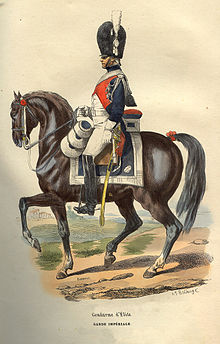Gendarmes d'élite de la Garde Impériale
| Gendarmes d'élite de la Garde impériale | |
|---|---|

Gendarme d'élite by Hippolyte Bellangé
|
|
| Active | 1801–15 |
| Country |
|
| Allegiance |
French Consulate First French Empire |
| Branch | Imperial Guard |
| Type | Gendarmerie |
| Size | One legion of two squadrons and two infantry companies (632 men, at full strength) |
| Nickname(s) | "The Immortals" (Les Immortels) |
| Engagements | Medina de Rioseco, Montmirail, Waterloo |
| Commanders | |
| Notable commanders |
Anne Jean Marie René Savary |
The Gendarmes d'élite de la Garde impériale (English: "élite gendarmes of the Imperial Guard") was a gendarmerie unit formed in 1801 by Napoleon as part of the Consular Guard which became the Imperial Guard in 1804. In time of peace, their role was to protect official residences and palaces and to provide security to important political figures. In time of war, their role was to protect the Imperial headquarters, to escort prisoners and occasionally to enforce the law and limit civil disorder in conquered cities. The unit was renamed Gendarmes des chasses du roi during the First Bourbon Restoration but was disbanded in 1815 during the Second Restoration.
A squadron of Gendarmes d'élite was raised in 1801 and integrated into the Consular Guard. In 1804, the unit comprised two cavalry squadrons and two companies of infantry which were now part of the Imperial Guard. At full strength they were 632 men, but the infantry companies were disbanded in 1806 and only 456 cavalrymen remained in the unit. The men should be at least 1.76 metres (5 ft 9 in) tall in order to enter the unit.
A platoon of the Gendarmes d'élite was in charge of the execution of the Duke of Enghien in 1804. The same year a detachment of the Gendarmes d'élite escorted Napoleon in the street of Paris for his coronation.
The Gendarmes d'élite were nicknamed "The Immortals" because, as a military police, they were less engaged in combat than other units and had less personnel killed in action. However, when committed into combat they fought bravely and earned several battle honours.
About 105 Gendarmes d'élite took part in the repression of the revolt of Madrid in 1808. A detachment of 56 gendarmes were part of Lassalle's great charge against Spanish positions at Medina de Rioseco (1808). They fought also at the siege of Astorga and the siege of Ciudad Rodrigo (1810).
...
Wikipedia
